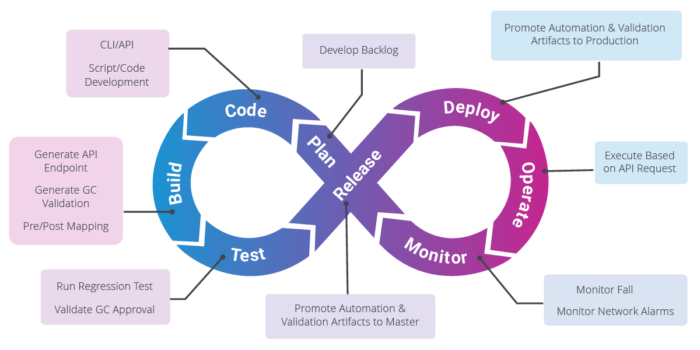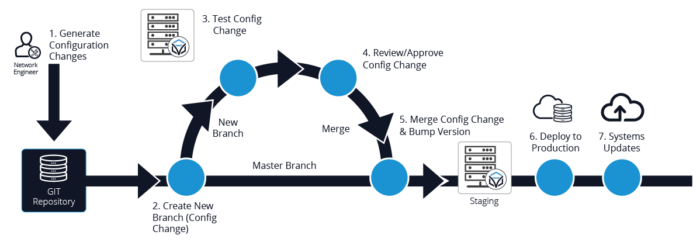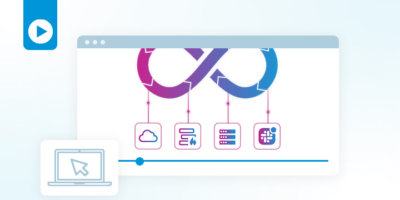Share this

In a recent white paper on the shift left for networking, we outlined how a more dynamic networking environment needs to be built to tie together DevOps teams with network operations (NetOps) teams to create a new foundation of NetDevOps.
Shift left means implementing the business goals, testing, and quality control of an application or a service further to the left in the development process to identify issues or optimizations as early as possible. Using a NetDevOps approach, networking environments can shift the provisioning and management of network infrastructure into the development process to become more programmable and automated.
This joint white paper with Itential outlines numerous benefits of the shift left for networking – including better programmability, integration among diverse networking domains, and automation. The ultimate goal of NetDevOps and shift left is to build networking functionality directly into an application, making networking part of the software development process itself.
We also point out how some of the more successful innovations in networking in the past few years – such as software-defined wide-area networking (SD-WAN) – are in fact software-driven developments that allow better automation and programmability using Applications Programming Interfaces (APIs).
Shift left is about expanding on this concept, to build programmability everywhere. But one question you might have is: What are the keys to success?
Building A NetDevOps Mindset
The answer, of course, comes down to people. Many challenges are based on culture and training.
Network operations teams have been trained for decades on specialized, often proprietary systems that are not designed to work well together. Vertical integration of software and hardware is both a blessing and a curse. It can provide better integration for one vendor’s systems, but it doesn’t always play well in a multi-domain environment.
With the advent of cloud, cross-domain networking functionality is becoming more important to connect and leverage cloud infrastructure. Applications often run on different cloud services, requiring dynamic network connectivity for data or access. Networks no longer exist as islands in an enterprise. It’s becoming more important to build programmability into networks than ever before.

In fact, this trend will become even stronger, as organizations move to building hybrid cloud infrastructure. In a recent survey by Cisco, 80% of IT leaders said they are adopting hybrid cloud, which will require more programmable networks driven by NetDevOps.
A Cultural Shift Left
One of the keys to success in leveraging these new cloud services and infrastructure will be building networks that can shift left to integrate with development and software. But this is not an easy process – it requires new training and organizational movement.
The first challenge for shift left includes setting up the organizations so that NetOps and DevOps teams can work together as one NetDevOps team.
Leaders need to make clear that the goal of shifting networks left is to build a better operations environment, freeing up staff time for more strategic tasks. They also need to demonstrate how network automation and NetDevOps tools can make their jobs easier and possibly more exciting, by eliminating tedious, repetitive tasks and saving costs.
Overall, these shifts would develop a stronger operational model for the organization as a whole, in which networking changes such as configurations and testing can be increasingly automated.

Incremental Moves Are Okay
This process of shifting left does not have to be sudden or extreme – it can be incremental. Processes can be changed in stages to facilitate new operational models.
With NetOps and DevOps teams working together, the intent, policy, and needs of the networking infrastructure can become mostly invisible to most users, which is the ultimate goal of automation. Those who come from the networking world may be familiar with some or all the elements of NetOps, but not DevOps; and for those from DevOps, the reverse may be true. But both efforts do seek the same goal: Building better automation for the sake of efficiency and performance.
NetOps teams can be shown the importance of instrumentation and of automated testing and validation. Once these steps are attained, deeper integrations with DevOps processes such as CI/CD pipeline integration can be tackled.
In might be easier to think about moving to these changes if they are considered as three separate goals:
- Adopt: Design, build and publish low-code automations as an API to be used in developer’s pipelines.
- Integrate: Incorporate pipeline calls with automation workflows to execute network changes during testing and deployment phases.
- Orchestrate: Pipelines fully orchestrate infrastructure and network automation use cases while leveraging Itential’s Network as a Service (NaaS) APIs.
Eventually, networking teams may start to migrate away from some of the many vendor-specific management platforms and CLIs they have become comfortable with to assimilate more powerful automation tools. Many manual, human-based processes will eventually be replaced with low-code or no-code automations: For example, using APIs to program network changes based on intent and development specifications.
NetDevOps doesn’t mean completely abandoning prior systems – it means implementing better automation software that can facilitate the evolution and integration with today’s modern cloud infrastructure.
To dive deeper into what the shift left means for networking, check out this new white paper or this webinar where I join Itential’s CTO Chris Wade to explore how IT leaders can enable a true shift left by adopting automation.




